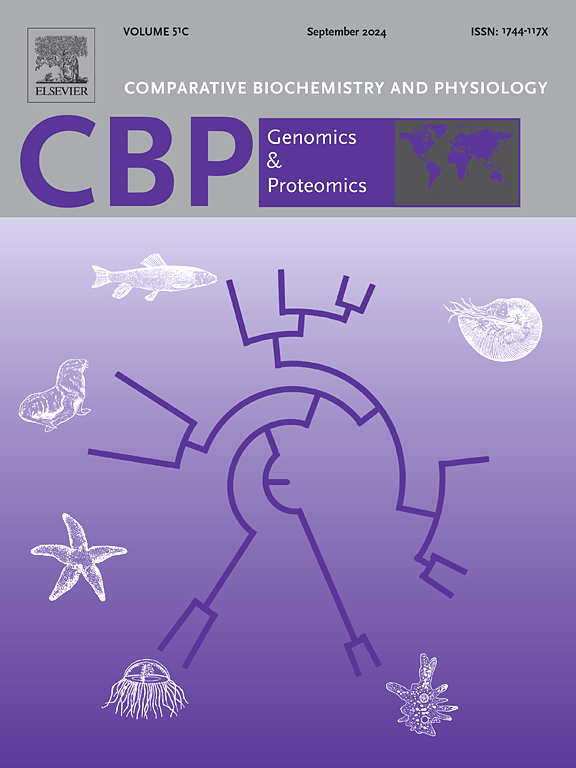鲮鱼的转化生长因子-β基因家族:全基因组分子特征以及与其他脊椎动物的系统发育关系
IF 2.2
2区 生物学
Q4 BIOCHEMISTRY & MOLECULAR BIOLOGY
Comparative Biochemistry and Physiology D-Genomics & Proteomics
Pub Date : 2025-04-21
DOI:10.1016/j.cbd.2025.101511
引用次数: 0
摘要
动物遗传学、生物技术和生物信息学方面的最新进展可能有助于提高鱼类产量和质量。本研究首次发现了转化生长因子-β (TGF-β)基因家族中的多种基因,这些基因在罗氏拉贝鱼(Labeo rohita)的生长发育中起着至关重要的作用。通过对所选基因进行表征、多重比对和进化支方向的系统发育、双Synteny分析和染色体分布、蛋白质表征、蛋白质二级结构和三维模型、PROSITE扫描分析和所选基因的转录因子结合位点(TFBSs)等工具和分析,探讨了所选基因与参考物种(Homo sapiens、Danio rerio、Oreochromis niloticus、Chelonia mydas和Parus major)。本研究评估了TGF-β基因家族中的27个基因。结果表明,除少数例外,所研究基因的理化特性均表现出基本性质。通过对6种脊椎动物的系统发育分析,获得了两个主要分支(BPM样分支和GDF样分支)。TGF-β基因超家族所选基因的基因结构均呈均匀性。TGF-β家族和TGF-β前肽家族在研究基因的结构域中占优势。基因结构比较提示TGF-β基因超家族是由基因复制事件产生的。研究发现了5对与Ka/Ks <;1、说明这些基因的负选择压力。所选TFBSs (GATA、HOXD、STAT、HNF-1A和YY1)的长度在5 ~ 9 bp之间,HOXD的长度最大。本研究对罗氏乳杆菌TGF-β基因家族及相关蛋白的分子特征进行了探索,将为开发改良鱼类养殖的新策略奠定基础。本文章由计算机程序翻译,如有差异,请以英文原文为准。

Transforming growth factor-beta gene family in Labeo rohita: Genome-wide molecular characterization and phylogenetic relationship with other vertebrates
Recent advancements in animal genetics, biotechnology, and bioinformatics can potentially contribute to the required improvement in fish production and quality. Current study explored for the first-time, various genes from Transforming growth factor-beta (TGF-β) gene family which could play vital role in growth and development of Labeo rohita, an economically important freshwater fish. A number of tools and analysis like characterizing the selected genes, multiple alignment and clade-wise phylogeny, dual Synteny analysis and chromosomal distribution, characterization of proteins, secondary structure and 3D models of proteins, PROSITE scan analysis, and transcription factor binding sites (TFBSs) of selected genes were performed to explore the relationship between selected genes from Labeo rohita and referenced species (Homo sapiens, Danio rerio, Oreochromis niloticus, Chelonia mydas, and Parus major). The study evaluated 27 genes from TGF-β gene family. The results suggested that physicochemical characteristics of studied genes exhibit a basic nature with the few exceptions. Two main clades (BPM like and GDF like) were obtained by the phylogenetic analysis across six vertebrate species. Homogeneity was observed in the gene structure for all selected genes of TGF-β gene superfamily. TGF-β family and TGF-β propeptide family were dominant in domain regions of studied genes. Gene structure comparisons suggested that the TGF-β gene superfamily has arisen by gene duplications events. The study identified five pairs of duplicated gene (segmental duplications) with the Ka/Ks < 1, indicating the negative selection pressure of these genes. The length of selected TFBSs (GATA, HOXD, STAT, HNF-1A, and YY1) ranged from 5 to 9 bp, with the HOXD having maximum bp. This study explored the molecular characterization for TGF-β gene family and related proteins in L. rohita and will potentially serve as basis of development of novel strategies in improvement of fish culture.
求助全文
通过发布文献求助,成功后即可免费获取论文全文。
去求助
来源期刊
CiteScore
5.10
自引率
3.30%
发文量
69
审稿时长
33 days
期刊介绍:
Comparative Biochemistry & Physiology (CBP) publishes papers in comparative, environmental and evolutionary physiology.
Part D: Genomics and Proteomics (CBPD), focuses on “omics” approaches to physiology, including comparative and functional genomics, metagenomics, transcriptomics, proteomics, metabolomics, and lipidomics. Most studies employ “omics” and/or system biology to test specific hypotheses about molecular and biochemical mechanisms underlying physiological responses to the environment. We encourage papers that address fundamental questions in comparative physiology and biochemistry rather than studies with a focus that is purely technical, methodological or descriptive in nature.

 求助内容:
求助内容: 应助结果提醒方式:
应助结果提醒方式:


